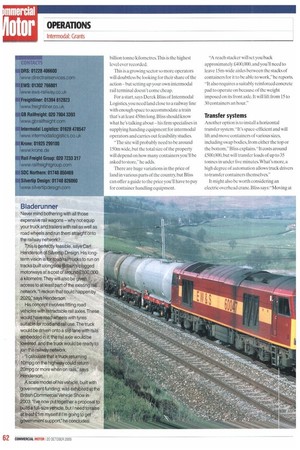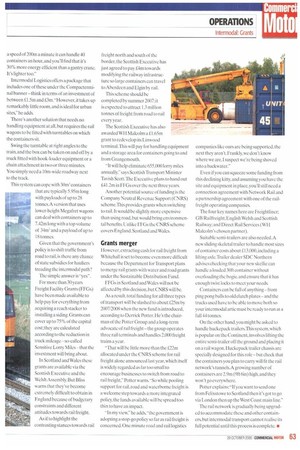OFF ROAD
Page 61

Page 62

Page 63

If you've noticed an error in this article please click here to report it so we can fix it.
With thethe government claiming to favour intermodal transport, why is it slashing funding for road-rail grants?
Steve Banner assesses the prospects for running on the rails.
With traffic congestion worsening as Britain's overburdened road network gradually crumbles, it's not surprising that some hauliers and their clients are using rail to shift containers.
While a truck is still required to transport the box from the railhead to its final destination, letting the train take the strain over long distances makes better sense than leaving cargo stuck on a motorway for hours on end.
That's especially the case when the cost of fuel and the nationwide shortage of truck drivers are factored into the equation. But some operators are finding that rail makes sense over shorter distances too.
Containerlift, for example, has just launched an intermodal service moving deep-sea containers between Thamesport andWillesdena distance ofjust 50 milesavoiding the clogged highways around the c,apital.The number of deep-sea containers entering the country is prompting more firms to move them inland by rail, according to pro' rail lobby group, the Rail Freight Group.
Cross-city transport
A rail user for several years,WH Malcolm offers a rail service between Grangemouth and Linwood to move boxes from one side of Glasgow to the other. It also runs between Grangemouth and Aberdeen. Grangemouth and Crick, and Crick and Mossend.
-We'll transfer 20 million road miles onto rail this year,says group chief executive Andrew Malcolm.
According to the National Rail Trends Yearbook, domestic intermodal traffic rose by 14.5% between 2003/4 and 2004/5 to four billion tonnetkilometres.This is the highest level ever recorded.
This is a growing sector so more operators will doubtless be looking for their share of the action— but setting up your own intennodal rail terminal doesn't come cheap.
For a start, says Derek Bliss of Intermodal Logistics, you need land close to a railway line with enough space to accommodate a train that's at least 450m long. Bliss should know what he's talking about — his firm specialises in supplying handing equipment for intermodal operators and carries out feasibility studies.
"The site will probably need to be around 150m wide, but the total size of the property will depend on how many containers you'll be asked to store," he adds.
There are huge variations in the price of land in various parts of the country, but Bliss can offer a guide to the price you'll have to pay for container handling equipment. "A reach stacker will set you back approximately i400,000, and you'll need to leave 15m-wide aisles between the stacks of containers for it to be able to work," he reports. "It also requires a suitably reinforced concrete pad to operate on because of the weight imposed on its front axle. It will lift from 15 to 30 containers an hour."
Transfer systems
Another option is to install a horizontal transfer system."It's space-efficient and will lift and move containers of various sizes, including swap bodies, from either the top or the bottom," Bliss explains. "It costs around £500,000, but will transfer loads of up to 35 tonnes in under five minutes. What's more, a high degree of automation allows truck drivers to transfer containers themselves."
It might also be worth considering an electric overhead crane. Bliss says: "Moving at a speed of 200m a minute it can handle 40 containers an hour, and you'll find that it's 30% more energy efficient than a gantry crane. It's lighter too."
In termodal Logistics offers a package that includes one of these under the Compacterminal banner -think in terms of an investment of between £1.5m and £3m." However, it takes up remarkably little room, and is ideal for urban sites," he adds.
There's another solution that needs no handling equipment at all, but requires the rail wagons to be fitted with turntables on which the containers sit.
Swing the turntable at right angles to the train, and the box can be taken on and off by a truck fitted with hook-loader equipment or a chain attachment in two or three minutes. You simply need a 10m-wide roadway next to the track.
This system can cope with 30m3 containers that are typically 5.95m long with payloads of up to 28 tonnes. A version that uses lower-height Megafret wagons can deal with containers up to 7.42m long with a top volume of 34m3 and a payload of up to 18 tonnes.
Given that the government's policy is to shift traffic from road to rail, is there any chance of state subsidies for hauliers treading the intermodal path?
The simple answer is "yes".
For more than 30 years Freight Facility Grants (FFGs) have been made available to help pay for everything from acquiring a reach stacker to installing a siding. Grants can cover up to 75% of the capital cost; they are calculated according to the reduction in truck mileage -so-called Sensitive Lorry Miles that the investment will bring about.
In Scotland and Wales these grants are available via the Scottish Executive and the Welsh A ssembly.But Bliss warns that they've become extremely difficult to obtain in England because of budgetary constraints and different attitudes towards rail freight.
As if to highlight the contrasting stances towards rail freight north and south of the border, the Scottish Executive has just agreed to pay £4m towards modifying the railway infrastructure so large containers can travel to Aberdeen and Elgin by rail.
This scheme should be completed by summer 2007:it is expected to attract 1.3 million tonnes of freight from road to rail every year.
The Scottish Executive has also awarded WH Malcolm a l .65m grant to redevelop its Linwood terminal.This will pay for handling equipment and a storage area for containers going to and from Grangemouth.
It will help eliminate 655,000 lorry miles annually," says Scottish Transport Minister Tavish Scott.The Executive plans to hand out £41.2m in FFGs over the next three years.
Another potential source of funding is the Company Neutral Revenue Support (CNRS) scheme. This provides grants when switching to rail. It would be slightly more expensive than using road, but would bring environmental benefits. Unlike FFGs the CNRS scheme covers England. Scotland and Wales.
Grants merger
However, extracting cash for rail freight from Whitehall is set to become even more difficult because the Department for Transport plans to merge rail grants with water and road grants under the Sustainable Distribution Fund.
FFGs in Scotland and Wales will not be affected by this decision, but CNRS will be.
As a result, total funding for all three types of transport will be slashed to about £25m by 2007/2008 when the new fund is introduced, according to Derrick Potter. He's the chairman of the Potter Group and a long-term advocate of rail freight the group operates three rail terminals and handles 2.000 freight trains a year.
"That will be little more than the £22m allocated under the CNRS scheme for rail freight alone announced last year, which itself is widely regarded as far too small to encourage businesses to switch from road to rail freight," Potter warns. "So while pooling support for rail, road and waterborne freight is a welcome step towards a more integrated policy, the funds available will be spread too thin to have an impact.
-In my view." he adds. "the government is adopting a stop-go policy so far as rail freight is concerned. One minute road and rail logistics companies like ours are being supported, the next they aren't. Frankly, we don't know where we are. I suspect we're being shoved into a backwater."
Even if you can squeeze some funding from this declining kitty. and assuming you have the site and equipment in place, you'll still need a connection agreement with Network Rail and a partnership agreement with one of the railfreight operating companies.
The four key names here are Freightliner; GB Railfreight; English Welsh and Scottish Railway; and Direct Rail Services (WH Malcolm's chosen partner).
Suitable semi-trailers are also needed. A new sliding skeletal trailer to handle most sizes of container costs about £13,000, including a lifting axle.Trailer dealer SDC Northern advises checking that your new skellie can handle a loaded 30ft container without overloading the bogie, and ensure that it has enough twist locks to meet your needs.
Containers can be full of anythingfrom ping pong balls to old clutch platesand the trucks used have Lobe able to move both so your intermodal artic must be ready to run at a full 44 tonnes.
On the other hand, you might he asked to handle huckepack trailers.This system, which is popular on the Continent, involves lifting the entire semi-trailer off the ground and placing it on a rail wagon. Huckepack trailer chassis are specially designed for this role but check that the containers you plan to carry will fit the rail network's tunnels.A growing number of containers are 2.9m (9ft 6in) high, and they won't go everywhere.
Potter explains: "If you want to send one Irom Felixstowe to Scotland then it's got to go via London then up the West Coast main line."
The rail network is gradually being upgraded to accommodate these and other containers, but intermodal transport cannot realise its full potential until this process is complete. •










































































































































































































